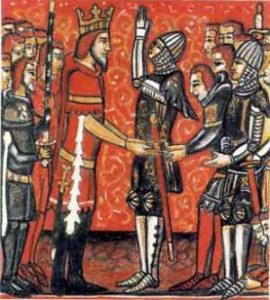I’ve been wanting to write this article for a long time, but the topic is so complicated that I’ve been afraid to tackle it. Why? The personification of a knight has changed over the centuries and most scholars don’t go there. I don’t need to reinvent the proverbial wheel; we all recognize the classic knight from the crusades and jousting tournaments. My aim in this article is to fine-tune the different layers of knights in the fourteenth and fifteenth century (which is the period of my study) who served the king.
This all started for me when I kept reading about chamber knights in Richard II’s household. Already I was baffled. What exactly was a chamber knight? Ever since then I’ve been piecing together bits and pieces of historical tidbits, until finally I stumbled across an article written by my favorite Richard II historian, Chris Given-Wilson. The title threw me: “The King and Gentry in Fourteenth-Century England”. (There’s another conundrum: how to define Gentry. I’ll save that for another article.) Thanks to his explanations here (and elsewhere), I’m ready to take the plunge. If you know something I’ve missed, please jump in!
As expected, in the twelfth and thirteenth centuries, the knight and his relationship with the king was primarily military. According to Given-Wilson, the household knights (familia regis) were kept on retainer: “They were the core of the king’s retinue, his nucleus of shock-troops, a force in itself, and capable of rapid expansion whenever necessary.” Apparently this last statement was important; the number of household knights was modest—somewhere around 30-70—but as soon as military action was demanded, their numbers jumped considerably—maybe as high as 120—then back again. These household knights were divided into two groups, depending on their military rank: the simple knight (also knight bachelor, who fought under someone else’s banner) and the banneret. The knight-banneret led his own contingent of knights and esquires and was entitled to carry a square banner instead of the triangular pennon for regular knights. He was also paid double the wages of a simple knight.
Around 1360, the knights gradually evolved into chamber knights who were “trusted royal servants valued by the king for their counsel, their administrative ability, and their domestic service as much as for their strong right arms”. Naturally their military function was important, but from then until the end of the century the king was—for the most part—inactive militarily. He just didn’t need a core of fighting knights around him (until the last three years of Richard’s reign, his so-called tyranny). The chamber knights were closely attached to the king, and sometimes served as diplomats, special commissioners, and companions; they were given castles and manors to administer, and sent as ambassadors to foreign powers and even to negotiate the king’s marriages. Their numbers were much more limited: “under Edward III, between 1366 and 1377, they number between three and five; under Richard II and Henry IV, they number between eight and thirteen. During the fifteenth century, they came to be known as ‘knights of the body’.”
From 1377 (the beginning of Richard II’s reign) through 1413 (the end of Henry IV’s reign) most knights retained by the king primarily served a different function outside the household and were known as the king’s knights (milites regis). Their job was to exert influence and authority in their shires. They didn’t receive robes and fees through the wardrobe like the chamber knights, but they were granted annuities. The king’s knights were sheriffs and justices of the peace, or represented their shires in parliament. The important aspect of this is that these knights were not separate from the gentry; for the most part, they were the gentry. Many knights were also landowners and belonged to that class, ranking just below the baronage. “The knightly class,” he tells us, “was the nobility”. And the gentry were rapidly becoming a key element in national politics.
<span style="display: inline-block; width: 0px; overflow: hidden; line-height: 0;" data-mce-type="bookmark" class="mce_SELRES_start"></span>
Just to complicate things further, the king also started to retain king’s esquires for considerably less money than the knights (many, but not all of them were esquires of the household). According to Given-Wilson, “If for the moment we exclude the years 1397-99, the over-all figures for king’s knights and king’s esquires during the two reigns are not dissimilar: under Richard II, there were about 150 knights and 105 esquires; under Henry IV, about 140 of each.” The esquires’ careers were similar to the knights but with less prestige and importance, though sometimes this was a stepping stone to becoming knights of the chamber. Nonetheless, most esquires actually possessed the lineage to become a knight, but the fee for their equipment and the cost of the dubbing ceremony deterred them from taking that step. So by this time, the gap in status between knights and squires was narrowing. By the mid-fourteenth century esquires were even permitted to bear coats of arms. So Given-Wilson places them squarely into the knightly class. More on this when we get to the gentry!
FURTHER READING:
Given-Wilson, Chris, THE ENGLISH NOBILITY IN THE LATE MIDDLE AGES, Routledge & Kegan Paul, London, 1987
Given-Wilson, Chris, THE KING AND THE GENTRY IN FOURTEENTH-CENTURY ENGLAND, Transactions of the Royal Historical Society, Vol. 37 (1987), pp. 87-102
Given-Wilson, Chris, THE ROYAL HOUSEHOLD AND THE KING’S AFFINITY, Yale University Press, New Haven, 1986


No comments:
Post a Comment